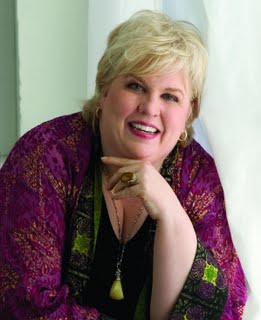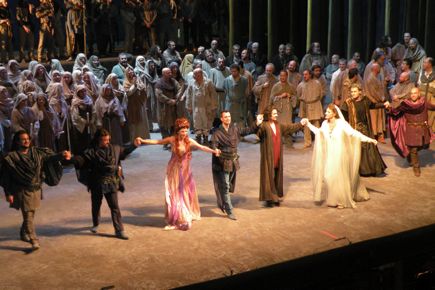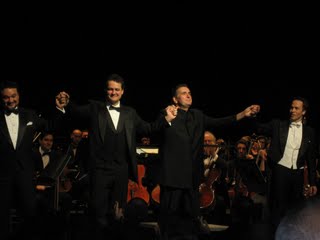Szymanowski's Opera "King Roger" Reconsidered

Classical Travels
This Week in Spain
King Roger was a real person who reigned in Sicily circa 1130 and whose court was widely recognized for its high level of intellectual knowledge and discourse. Szymanowski's opera King Roger (1926)was inspired by the composer's travels in the Mediterranean region - more specifically, Sicily, where he became fascinated by the unique interplay of the cultures of ancient Greece and the Arab world.
I first came to know King Roger through recordings. It was only recently that I finally saw a live performance - at the venerable Gran Theatre del Liceu in Barcelona, Spain.
One of the main themes in King Roger is borrowed from Euripedes drama "The Bacchae", in which another ruler - King Pentheus - is torn to pieces by followers of the god Dionysus. In the course of writing King Roger - Szymanowski eventually wrote most of the text as well as the music - the work became a series of three tableaus representing encounters between King Roger and Dionysus.
In the first production of King Roger (Warsaw, Poland), of which there is a photograph of the Act One setting in the fine programme booklet for the Liceu Opera production, great care was taken by the set designer to bring to life the historical context of the opera; hence, the audience saw a real church with the figure of Christ looming large at its centre in Act One; a real palace in Act Two; and the ruins of a Greek theatre in Act Three. All of these settings and more are called for in the composer's detailed stage directions.
Abstract Approach Brings Apollo/Dionysus Conflict to Life
For Barcelona's Gran Theatre del Liceu production, British director David Pountney chose to present King Roger in a more abstract way. One set design served for all three acts of the opera: a series of risers upon which most of the action took place. Costumes were non-historical. The men wore black robes or suits. King Roger's wife Roxana wore a red dress of vaguely twentieth century style.
Although this 'abstract' new production, directed by David Pountney and conducted by Josef Pons, was far from faithful to Szymanowski's stated intentions, it nevertheless dealt with the opera's religious, philosophical and psychological elements in thought-provoking ways. The voices and orchestra were first-rate. The production was sung in Spanish with Catalan surtitles.
Pountney's purpose, as clearly stated in the Liceu Opera programme book, was to focus attention on the 'essence' of the opera, which he takes to be Roger's internal struggle between intellect and emotion, or between the Apollonian and the Dionysian elements of human nature. By extrapolation, this is a struggle shared by all mankind and so need not be limited by time and place.
Pountney's production not only explores the ideas and emotions of Szymanowski's characters, but attempts to illuminate the subtext of the composer's lyrics; for example, in his first appearance, the Shepherd/Dionysus character immediately arouses the interest of King Roger's wife, Roxana. Roger himself is at once repelled and fascinated by the pagan and blasphemous message transmitted by this charismatic stranger. He orders the Shepherd's arrest and then, almost immediately, rescinds the order.
In Pountney's production, there is a moment of extraordinary power when Roger approaches the Shepherd from behind and encircles him with his arms as if to take him into custody. In that very moment the 'capture' becomes a depiction of homosexual carnality. Roger has succumbed to desires he didn't even know he had and is henceforth more conflicted than ever about this man.
Throughout the opera, King Roger is shadowed by his advisor Edrisi, an 'Arabian sage'. Edrisi is the philosophical counterweight to Roger's wife Roxana. She is all about intuition and passion, while Edrisi is a man of reason and, in a way, Roger's conscience or higher self. Ultimately, Dionysus prevails and leads his followers, including Roxana to experience the ultimate rites of his sect. In the opera, Roger and Edrisi experience them too and return, almost destroyed by the experience. They stagger onstage, covered in blood, and Edrisi, the voice of reason and Roger's conscience, is near death.
Are we to think then that Dionysus has won in the end?
Not so fast! As the sun rises behind him, King Roger turns, and offers himself up to it - an affirmation of the ultimate power of Apollo and reason. He has been tempted by the mysteries of Dionysus, he has been changed by the experience - they are after all a celebration of a vital part of human nature - and he has emerged a stronger and wiser man.
It must be stressed that while the opera begins with an affirmation of Christian worship, Christian faith is not really the central issue. At the end of the opera, King Roger clearly does not reaffirm his faith in Christ and Christian values, but rather in the older and more fundamental Apollonian ideal. For another example of how these themes have been explored in profound ways by another twentieth century composer, I suggest readers view Benjamin Britten's opera Death in Venice.
Physical and Vocal Demands of Production Well Met
While a discussion of ideas is necessary to any appreciation of Szymanowski's King Roger, it would not be a work worth reviving, were the music not extraordinary. The opera opens with old-fashioned choral music to suggest the atmosphere and tradition of Christian church music. It then goes on to more chromatic music, obviously influenced by the likes of Debussy, Ravel and Scriabin, with elements of Middle Eastern music as well. A similar blend of sources can be found in parts of Strauss' Salome.
The main characters in Pountney's King Roger are called upon to convey a vast range of ideas and emotions through their voices and through a demanding series of physical movements and so must be consummate singing actors. At the Gran Teatro del Liceu, with eight performances of the opera being given over a period of about two weeks, two casts are required.
In the production I saw, the role of King Roger was sung by the fine American baritone Scott Hendricks. I was interested to read in the programme that he has also done Death in Venice at the Liceu. Hendricks was matched every step of the way by the excellent German tenor Will Hartmann (Shepherd/Dionysus), making an auspicious debut at the Liceu. Hartmann faced the additional challenge of being required to don a woman's dress at one point in the opera, and later, of having his entire body painted in gold. The role of Roxana, in this production, was taken by the celebrated German soprano Anne Schwanewilms.
The busy chorus was wonderful. Maestro Josep Pons, associate principal conductor of the Liceu and also director of the Orquesta Nacional de España, gave us a sensitive and compelling reading of King Roger.
Painting with Light and Color Transforms Simple Set
I have described director David Pountney's approach to King Roger as 'abstract', and reported that the single set used was little more than a series of risers. There was, however, considerably more to the 'visual' side of this production than that series of risers, thanks to the wonderfully creative imaginations of set designer Raimund Bauer and lighting designer Fabrice Kebour, who was making his debut at the Liceu.
Bauer's risers had openings through which characters appeared and disappeared and the steps seemed to move as if characters themselves. The lighting introduced colours and patterns that played upon the risers, closely relating to the flow of the music and the drama. The result was substantial music drama in which all the elements worked together based on a common understanding of the text and the music.
King Roger will never be a popular opera - it has too much intellectual content and too little commercial appeal for that - but it deserves to be performed more often, especially in productions as serious and resourceful as this one.
Paul E. Robinson is the author of Herbert von Karajan: the Maestro as Superstar, and Sir Georg Solti: His Life and Music, both available at Amazon.com.
Labels: Austin Lyric Opera, Barcelona, Gran Theatre del Liceu, King Roger, Spain., Szymanowski






